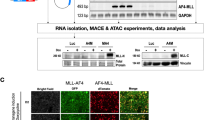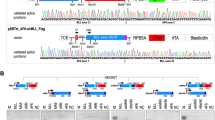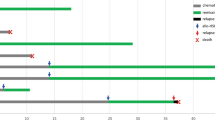Abstract
The human mixed lineage leukemia (MLL) gene is frequently involved in genetic rearrangements with more than 55 different translocation partner genes, all associated with acute leukemia. Reciprocal chromosomal translocations generate two MLL fusion alleles, where 5′- and 3′-portions of MLL are fused to gene segments of given fusion partners. In case of t(4;11) patients, about 80% of all patients exhibit both reciprocal fusion alleles, MLL · AF4 and AF4 · MLL, respectively. By contrast, 20% of all t(4;11) patients seem to encode only the MLL · AF4 fusion allele. Here, we analyzed these ’MLL·AF4+/AF4·MLL−’ patients at the genomic DNA level to unravel their genetic situation. Cryptic translocations and three-way translocations were found in this group of t(4;11) patients. Reciprocal MLL fusions with novel translocation partner genes, for example NF- K B1 and RABGAP1L, were identified and actively transcribed in leukemic cells. In other patients, the reciprocal 3′-MLL gene segment was fused out-of-frame to PBX1, ELF2, DSCAML1 and FXYD6. The latter rearrangements caused haploinsufficiency of genes that are normally expressed in hematopoietic cells. Finally, patients were identified that encode only solitary 3′-MLL gene segments on the reciprocal allele. Based on these data, we propose that all t(4;11) patients exhibit reciprocal MLL alleles, but due to the individual recombination events, provide different pathological disease mechanisms.
This is a preview of subscription content, access via your institution
Access options
Subscribe to this journal
Receive 12 print issues and online access
$259.00 per year
only $21.58 per issue
Buy this article
- Purchase on Springer Link
- Instant access to full article PDF
Prices may be subject to local taxes which are calculated during checkout



Similar content being viewed by others
References
Felix CA, Hosler MR, Winick NJ, Masterson M, Wilson AE, Lange BJ . ALL-1 gene rearrangements in DNA topoisomerase II inhibitor-related leukemia in children. Blood 1995; 85: 3250–3256.
Mitterbauer-Hohendanner G, Mannhalter C . The biological and clinical significance of MLL abnormalities in haematological malignancies. Eur J Clin Invest 2004; 34 (Suppl 2): 12–24.
Rowley JD . The der(11) chromosome contains the critical breakpoint junction in the 4;11, 9;11, and 11;19 translocations in acute leukemia. Genes Chrom Cancer 1992; 5: 264–266.
Meyer C, Schneider B, Jakob S, Strehl S, Attarbaschi A, Schnittger S et al. The MLL recombinome of acute leukemias. Leukemia 2006a; 20: 777–784.
Meyer C, Kowarz E, Oehm C, Klingebiel T, Dingermann T, Marschalek R . Genomic DNA of leukemia patients: target for clinical diagnosis of MLL rearrangements. Biotechnol J 2006b; 1: 656–663.
Ayton PM, Cleary ML . Molecular mechanisms of leukemogenesis mediated by MLL fusion proteins. Oncogene 2001; 20: 5695–5707.
Hess JL . Mechanisms of transformation by MLL. Crit Rev Eukaryot Gene Expr 2004; 14: 235–254.
Horton SJ, Grier DG, McGonigle GJ, Thompson A, Morrow M, De Silva I et al. Continuous MLL-ENL expression is necessary to establish a ‘Hox Code’ and maintain immortalization of hematopoietic progenitor cells. Cancer Res 2005; 65: 9245–9252.
Rozovskaia T, Feinstein E, Mor O, Foa R, Blechman J, Nakamura T et al. Upregulation of Meis1 and HoxA9 in acute lymphocytic leukemias with the t(4;11) abnormality. Oncogene 2001; 20: 874–878.
Ayton PM, Cleary ML . Transformation of myeloid progenitors by MLL oncoproteins is dependent on Hoxa7 and Hoxa9. Genes Dev 2003; 17: 2298–2307.
Zeisig BB, Milne T, Garcia-Cuellar MP, Schreiner S, Martin ME, Fuchs U et al. Hoxa9 and Meis1 are key targets for MLL-ENL-mediated cellular immortalization. Mol Cell Biol 2004; 24: 617–628.
Hess JL, Bittner CB, Zeisig DT, Bach C, Fuchs U, Borkhardt A et al. c-Myb is an essential downstream target for homeobox-mediated transformation of hematopoietic cells. Blood 2006; 108: 297–304.
Xia ZB, Popovic R, Chen J, Theisler C, Stuart T, Santillan DA et al. The MLL fusion gene, MLL-AF4, regulates cyclin-dependent kinase inhibitor CDKN1B (p27kip1) expression. Proc Natl Acad Sci USA 2005; 102: 14028–14033.
Gaussmann A, Wenger T, Eberle I, Bursen A, Bracharz S, Herr I et al. The combined effects of the two reciprocal t(4;11) fusion proteins, MLL·AF4 and AF4·MLL, confer resistance to apoptosis, cell cycling capacity and growth transformation. Oncogene 2006, [E pub ahead of print].
Milne TA, Hughes CM, Lloyd R, Yang Z, Rozenblatt-Rosen O, Dou Y et al. Menin and MLL cooperatively regulate expression of cyclin-dependent kinase inhibitors. Proc Natl Acad Sci USA 2005a; 102: 749–754.
Milne TA, Dou Y, Martin ME, Brock HW, Roeder RG, Hess JL . MLL associates specifically with a subset of transcriptionally active target genes. Proc Natl Acad Sci USA 2005b; 102: 14765–14770.
Milne TA, Martin ME, Brock HW, Slany RK, Hess JL . Leukemogenic MLL fusion proteins bind across a broad region of the Hox a9 locus, promoting transcription and multiple histone modifications. Cancer Res 2005c; 65: 11367–11374.
Corral J, Lavenir I, Impey H, Warren AJ, Forster A, Larson TA et al. An Mll-AF9 fusion gene made by homologous recombination causes acute leukemia in chimeric mice: a method to create fusion oncogenes. Cell 1996; 85: 853–861.
Lavau C, Szilvassy SJ, Slany R, Cleary ML . Immortalization and leukemic transformation of a myelomonocytic precursor by retrovirally transduced HRX-ENL. EMBO J 1997; 16: 4226–4237.
Slany RK, Lavau C, Cleary ML . The oncogenic capacity of HRX-ENL requires the transcriptional transactivation activity of ENL and the DNA binding motifs of HRX. Mol Cell Biol 1998; 18: 122–129.
Dobson CL, Warren AJ, Pannell R, Forster A, Lavenir I, Corral J et al. The Mll-AF9 gene fusion in mice controls myeloproliferation and specifies acute myeloid leukaemogenesis. EMBO J 1999; 18: 3564–3574.
DiMartino JF, Miller T, Ayton PM, Landewe T, Hess JL, Cleary ML et al. A carboxy-terminal domain of ELL is required and sufficient for immortalization of myeloid progenitors by MLL-ELL. Blood 2000; 96: 3887–3893.
Lavau C, Du C, Thirman M, Zeleznik-Le N . Chromatin-related properties of CBP fused to MLL generate a myelodysplastic-like syndrome that evolves into myeloid leukemia. EMBO J 2000a; 19: 4655–4664.
Lavau C, Luo RT, Du C, Thirman MJ . Retrovirus-mediated gene transfer of MLL-ELL transforms primary myeloid progenitors and causes acute myeloid leukemias in mice. Proc Natl Acad Sci USA 2000b; 97: 10984–10989.
DiMartino JF, Ayton PM, Chen EH, Naftzger CC, Young BD, Cleary ML . The AF10 leucine zipper is required for leukemic transformation of myeloid progenitors by MLL-AF10. Blood 2002; 99: 3780–3785.
Eguchi M, Eguchi-Ishimae M, Greaves M . The small oligomerization domain of gephyrin converts MLL to an oncogene. Blood 2004; 103: 3876–3882.
Liu H, Chen B, Xiong H, Huang QH, Zhang QH, Wang ZG et al. Functional contribution of EEN to leukemogenic transformation by MLL-EEN fusion protein. Oncogene 2004; 23: 3385–3394.
So CW, Karsunky H, Wong P, Weissman IL, Cleary ML . Leukemic transformation of hematopoietic progenitors by MLL-GAS7 in the absence of Hoxa7 or Hoxa9. Blood 2004a; 103: 3192–3199.
So CW, Cleary ML . Dimerization: a versatile switch for oncogenesis. Blood 2004; 104: 919–922.
Wang J, Iwasaki H, Krivtsov A, Febbo PG, Thorner AR, Ernst P et al. Conditional MLL-CBP targets GMP and models therapy-related myeloproliferative disease. EMBO J 2005; 24: 368–381.
Strehl S, Borkhardt A, Slany R, Fuchs UE, Konig M, Haas OA . The human LASP1 gene is fused to MLL in an acute myeloid leukemia with t(11;17)(q23;q21). Oncogene 2003; 22: 157–160.
Metzler M, Forster A, Pannell R, Arends MJ, Daser A, Lobato MN et al. A conditional model of MLL-AF4 B-cell tumourigenesis using invertor technology. Oncogene 2006; 25: 3093–3103.
Chen W, Li Q, Hudson WA, Kumar A, Kirchhof N, Kersey JH . A murine Mll-AF4 knock-in model results in lymphoid and myeloid deregulation and hematologic malignancy. Blood 2006; 108: 669–677.
Bursen A, Moritz S, Gaussmann A, Moritz S, Dingermann T, Marschalek R . Interaction of AF4 wild-type and AF4.MLL fusion protein with SIAH proteins: indication for t(4;11) pathobiology? Oncogene 2004; 23: 6237–6249.
Downing JR, Head DR, Raimondi SC, Carroll AJ, Curcio-Brint AM, Motroni TA et al. The der(11)-encoded MLL/AF-4 fusion transcript is consistently detected in t(4;11)(q21;q23)-containing acute lymphoblastic leukemia. Blood 1994; 83: 330–335.
Reichel M, Gillert E, Angermuller S, Hensel JP, Heidel F, Lode M et al. Biased distribution of chromosomal breakpoints involving the MLL gene in infants versus children and adults with t(4;11) ALL. Oncogene 2001; 20: 2900–2907.
Scharf S, Zech J, Bursen A, Schraets D, Oliver PL, Kliem S et al. Transcription linked to recombination: a gene-internal promoter coincides with the recombination hot spot II of the human MLL gene. Oncogene 2007; 26: 1361–1371.
Meyer C, Schneider B, Reichel M, Angermueller S, Strehl S, Schnittger S et al. Diagnostic tool for the identification of MLL rearrangements including unknown partner genes. Proc Natl Acad Sci USA 2005; 102: 449–454.
van Dongen JJ, Macintyre EA, Gabert JA, Delabesse E, Rossi V, Saglio G et al. Standardized RT-PCR analysis of fusion gene transcripts from chromosome aberrations in acute leukemia for detection of minimal residual disease. Report of the BIOMED-1 Concerted Action: investigation of minimal residual disease in acute leukemia. Leukemia 1999; 13: 1901–1928.
van der Burg M, Beverloo HB, Langerak AW, Wijsman J, van Drunen E, Slater R et al. Rapid and sensitive detection of all types of MLL gene translocations with a single FISH probe set. Leukemia 1999; 13: 2107–2113.
Andersson A, Höglund M, Johansson B, Lassen C, Billström R, Garwicz S et al. Paired multiplex reverse-transcriptase polymerase chain reaction (PMRT-PCR) analysis as a rapid and accurate diagnostic tool for the detection of MLL fusion genes in hematologic malignancies. Leukemia 2001; 15: 1293–1300.
van der Burg M, Poulsen TS, Hunger SP, Beverloo HB, Smit EM, Vang-Nielsen K et al. Split-signal FISH for detection of chromosome aberrations in acute lymphoblastic leukemia. Leukemia 2004; 18: 895–908.
Raffini LJ, Slater DJ, Rappaport EF, Nigro LL, Cheung NK, Biegel JA et al. Panhandle and reverse-panhandle PCR enable cloning of der(11) and der(other) genomic breakpoint junctions of MLL translocations and identify complex translocation of MLL, AF-4, and CDK6. Proc Natl Acad Sci USA 2002; 99: 4568–4573.
Harrison CJ, Cuneo A, Clark R, Johansson B, Lafage-Pochitaloff M, Mugneret F et al. Ten novel 11q23 chromosomal partner sites. European 11q23 Workshop participants. Leukemia 1998; 12: 811–822.
Meyer C, Burmeister T, Strehl S, Schneider B, Hubert D, Zach O et al. Spliced MLL fusions: a novel mechanism to generate functional chimaeric MLL · MLLT1 transcripts in t(11;19)(q23;p13.3) leukaemia. Leukemia 2007; 21: 588–590.
Hunger SP, Galili N, Carroll AJ, Crist WM, Link MP, Cleary ML . The t(1;19)(q23;p13) results in consistent fusion of E2A and PBX1 coding sequences in acute lymphoblastic leukemias. Blood 1991; 77: 687–693.
Kamps MP, Look AT, Baltimore D . The human t(1;19) translocation in pre-B ALL produces multiple nuclear E2A-Pbx1 fusion proteins with differing transforming potentials. Genes Dev 1991; 5: 358–368.
Wang GG, Pasillas MP, Kamps MP . Persistent transactivation by meis1 replaces hox function in myeloid leukemogenesis models: evidence for co-occupancy of meis1-pbx and hox-pbx complexes on promoters of leukemia-associated genes. Mol Cell Biol 2006; 26: 3902–3916.
Cho JY, Akbarali Y, Zerbini LF, Gu X, Boltax J, Wang Y et al. Isoforms of the Ets transcription factor NERF/ELF-2 physically interact with AML1 and mediate opposing effects on AML1-mediated transcription of the B cell-specific blk gene. J Biol Chem 2004; 279: 19512–19522.
Wildonger J, Mann RS . The t(8;21) translocation converts AML1 into a constitutive transcriptional repressor. Development 2005; 132: 2263–2272.
Kordes U, Krappmann D, Heissmeyer V, Ludwig WD, Scheidereit C . Transcription factor NF-kappaB is constitutively activated in acute lymphoblastic leukemia cells. Leukemia 2000; 14: 399–402.
Guzman ML, Neering SJ, Upchurch D, Grimes B, Howard DS, Rizzieri DA et al. Nuclear factor-kappaB is constitutively activated in primitive human acute myelogenous leukemia cells. Blood 2001; 98: 2301–2307.
Acknowledgements
This study was supported by grants MA 1876/7-1 from the DFG, N1KR-S12T13 from the BMBF, 2001.061.2 from the Wilhelm-Sander-Foundation, and 102362 from the German Cancer Foundation to R.M. TB was supported by a grant from the Berliner Krebsgesellschaft. TB thanks Professor E. Thiel and Professor D. Hoelzer for their support and Ms. Mara Molkentin for excellent technical assistance.
Author information
Authors and Affiliations
Corresponding author
Rights and permissions
About this article
Cite this article
Kowarz, E., Burmeister, T., Lo Nigro, L. et al. Complex MLL rearrangements in t(4;11) leukemia patients with absent AF4 · MLL fusion allele. Leukemia 21, 1232–1238 (2007). https://doi.org/10.1038/sj.leu.2404686
Received:
Accepted:
Published:
Issue Date:
DOI: https://doi.org/10.1038/sj.leu.2404686
Keywords
This article is cited by
-
The role of reciprocal fusions in MLL-r acute leukemia: studying the chromosomal translocation t(4;11)
Oncogene (2021)
-
HDAC7 is a major contributor in the pathogenesis of infant t(4;11) proB acute lymphoblastic leukemia
Leukemia (2021)
-
Molecular processes involved in B cell acute lymphoblastic leukaemia
Cellular and Molecular Life Sciences (2018)
-
Array-based comparative genomic hybridization detects copy number variations with prognostic relevance in 80% of ALL with normal karyotype or failed chromosome analysis
Leukemia (2016)
-
Genomic analysis of a four-way t(4;11;22;10) associated with MLL-AF4 in an adult acute lymphoblastic leukemia
Annals of Hematology (2012)



